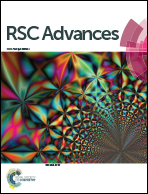Molecular and biochemical characterization of a new thermostable bacterial laccase from Meiothermus ruber DSM 1279†
Abstract
A new laccase gene (mrlac) from Meiothermus ruber DSM 1279 was successfully overexpressed to produce a laccase (Mrlac) in soluble form in Escherichia coli during simultaneous overexpression of a chaperone protein (GroEL/ES). Without the GroEL/ES protein, the Mrlac overexpressed in E. coli constituted a huge amount of the total cellular protein, but the enzyme was localized in the insoluble fraction with no activity in the soluble fraction. Co-expression of the Mrlac with the E. coli GroEL/ES drastically improved proper folding and expression of active Mrlac in the soluble fraction. Spectroscopic analysis of the purified enzyme by UV/visible and electron paramagnetic resonance spectroscopy confirmed that the Mrlac was a multicopper oxidase. The Mrlac had a molecular weight of ∼50 kDa and exhibited activity towards the canonical laccase substrates 2,2′-azino-bis(3-ethylbenzothiazoline-6-sulphonic acid) (ABTS), syringaldazine (SGZ), and 2,6-dimethoxyphenol (2,6-DMP). Kinetic constants Km and kcat were 27.3 μM and 325 min−1 on ABTS, 4.2 μM and 106 min−1 on SGZ, and 3.01 μM and 115 min−1 on 2,6-DMP, respectively. Maximal enzyme activity was achieved at 70 °C with ABTS as substrate. In addition, Mrlac exhibited a half-life for deactivation at 70 °C and 75 °C of about 120 min and 67 min, respectively, indicating that the Mrlac is intrinsically thermostable. Finally, Mrlac was efficient in catalyzing the removal of 2,4-dichlorophene (DCP) in aqueous solution, a trait which makes the enzyme potentially useful for environmentally friendly applications.


 Please wait while we load your content...
Please wait while we load your content...